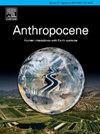青藏高原生态质量时空动态:可持续发展的驱动力、趋势与启示
IF 3.3
2区 地球科学
Q2 ENVIRONMENTAL SCIENCES
引用次数: 0
摘要
由于气候变化和人类活动的加剧,青藏高原是一个重要的生态前沿。利用遥感生态指数(RSEI)、Sen-Mann-Kendall趋势分析和决策树分类相结合的综合分析框架,研究了2000 - 2020年青藏高原生态质量的时空变化趋势。结果表明,17.32% %的青藏高原在研究期间出现了明显的生态改善,尤其是东部和北部。相比之下,只有2.70 %出现退化,主要在南部地区。时间研究揭示了2010-2020年期间向生态稳定的过渡,而2000-2010年期间则更加不稳定。归因研究表明,人类活动是生态变化的主要催化剂,影响了8.42% %的区域,在82.86 %的人类影响区域中观察到主要的积极影响,打破了人类活动对高海拔生态系统影响的传统观念。气候要素表现出复杂的影响,降水通常改善生态质量,而温度影响随着时间的推移从很大程度上有害转变为更加平衡。研究表明,草地恢复对生态增强特别有利,其中裸地向草地的转变是最实质性的积极变化。我们的研究结果强调了生态恢复措施的有效性,同时阐明了气候和人为因素之间的区域差异关系。这些发现强调了地理定制保护计划的必要性,以解决特定的区域问题,并利用已证明的恢复成果。本研究提高了我们对高海拔生境生物动态的认识,为青藏高原这一全球重要生态区域的可持续管理提供了科学依据。本文章由计算机程序翻译,如有差异,请以英文原文为准。
Spatiotemporal dynamics of ecological quality on the Qinghai-Tibet Plateau: Drivers, trends, and implications for sustainable development
The Qinghai-Tibet Plateau (QTP) is a vital ecological frontier undergoing significant environmental changes due to climate change and escalating human activity. This study examines the spatiotemporal trends of ecological quality across the QTP from 2000 to 2020 utilizing an integrated analytical framework that combines the Remote Sensing-based Ecological Index (RSEI), Sen-Mann-Kendall trend analysis, and decision tree classification. Our data indicate that 17.32 % of the plateau saw substantial ecological enhancement during the research period, especially in the eastern and northern parts. In contrast, only 2.70 % exhibited degradation, primarily in the southern portions. The temporal study revealed a transition towards ecological stabilization throughout the 2010–2020 timeframe in contrast to the more erratic 2000–2010 decade. Attribution study revealed that human activities were the primary catalyst of ecological change, influencing 8.42 % of the area, with predominantly positive effects observed in 82.86 % of human-affected regions, defying traditional beliefs regarding anthropogenic consequences in high-altitude ecosystems. Climate elements demonstrated intricate influences, with precipitation often improving ecological quality, whereas temperature effects transitioned from largely detrimental to more balanced over time. Examining land cover transitions revealed that grassland restoration is especially advantageous for ecological enhancement, with the conversion from bare land to grassland being the most substantial positive change. Our findings underscore the efficacy of ecological restoration initiatives while elucidating the regionally distinct relationships between climatic and anthropogenic factors. These findings highlight the necessity for geographically customized conservation programs that tackle particular regional issues and leverage proven restoration achievements. This research enhances our comprehension of biological dynamics in high-altitude habitats and establishes a scientific basis for the sustainable management of the QTP, a region of global ecological importance.
求助全文
通过发布文献求助,成功后即可免费获取论文全文。
去求助
来源期刊

Anthropocene
Earth and Planetary Sciences-Earth and Planetary Sciences (miscellaneous)
CiteScore
6.30
自引率
0.00%
发文量
27
审稿时长
102 days
期刊介绍:
Anthropocene is an interdisciplinary journal that publishes peer-reviewed works addressing the nature, scale, and extent of interactions that people have with Earth processes and systems. The scope of the journal includes the significance of human activities in altering Earth’s landscapes, oceans, the atmosphere, cryosphere, and ecosystems over a range of time and space scales - from global phenomena over geologic eras to single isolated events - including the linkages, couplings, and feedbacks among physical, chemical, and biological components of Earth systems. The journal also addresses how such alterations can have profound effects on, and implications for, human society. As the scale and pace of human interactions with Earth systems have intensified in recent decades, understanding human-induced alterations in the past and present is critical to our ability to anticipate, mitigate, and adapt to changes in the future. The journal aims to provide a venue to focus research findings, discussions, and debates toward advancing predictive understanding of human interactions with Earth systems - one of the grand challenges of our time.
 求助内容:
求助内容: 应助结果提醒方式:
应助结果提醒方式:


